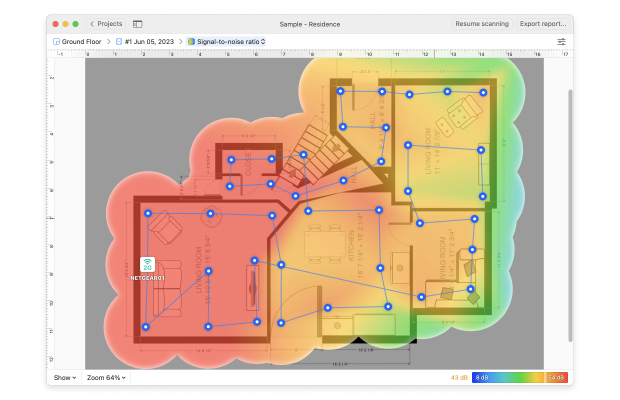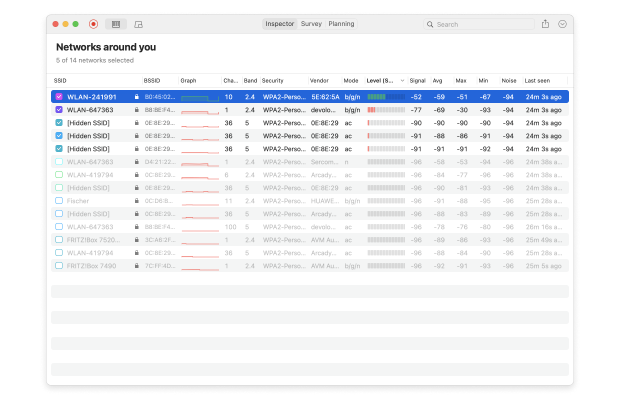WiFi speed test app runs on a MacBook (macOS 11+) or any laptop (Windows 7/8/10/11) with a standard 802.11be/ax/ac/n/g/a/b wireless network adapter. Read more about the 802.11be support here.
How to Increase WiFi Speed
In most cases, it’s only when websites and online videos suddenly take ages to load and buffer when we start to wonder how to increase WiFi speed, and if you’re in that situation right now, this article is for you.
When your Wi-Fi slows down, buffers endlessly, or drops during a video call, the cause could be anything from outdated hardware to interference from your neighbors’ networks. The good news — you can fix most issues yourself, without guesswork, if you follow the right steps and use the right tools. Below is a clear, no-nonsense guide on how to boost your Wi-Fi performance at home or in the office.
- 1. Verify your baseline first
- 2. Update and reboot (fast wins)
- 3. Place the router where RF actually works
- 4. Use the right band (and device support)
- 5. Balance network utilization with QoS and MU-MIMO
- 6. Modernize hardware when it’s the bottleneck
- 7. Extend coverage the right way
- 8. Verify changes with a walk test
- FAQ — Common Questions About Boosting Your Wi-Fi Speed
1. Verify your baseline first
Before making any changes, you need to see the real picture of your network. Run a wired speed test to confirm your plan’s real throughput.
Get a perfect WiFi speed with NetSpot
Don’t settle for a decent Internet connection, NetSpot ensures a consistent WiFi speed.Then test over Wi-Fi in the same room as the router and again in a problem spot. Repeat after each change so you know what actually helps.
If Ethernet is fine but Wi-Fi is slow, keep going.
Expert tip: latency/jitter moving a lot while throughput stays “ok” usually means interference or congestion, not ISP issues.
2. Update and reboot (fast wins)
Reboot modem + router (or your mesh kit). Then update router firmware and client drivers. Bugs and memory leaks degrade throughput and raise latency over time. Do this before any deeper tuning.
3. Place the router where RF actually works
The placement of your WiFi router can have a significant impact on your WiFi speed, and changing it is often the easiest way how to increase speed of WiFi because radios exchange packets both ways.
When these data packets encounter an impenetrable obstacle, such as a brick wall or a large metal appliance, they may lose their energy and not reach their target. But even lesser obstacles can negatively affect their ability to reach their target, which results in slowdowns and buffering.
That’s why you should always position your WiFi router as far away from obstacles as possible and as close to the center of the area you wish to cover with WiFi signal as possible.
To find the perfect place for your WiFi router, we highly recommend NetSpot, a professional app for wireless site surveys, Wi-Fi analysis, and troubleshooting that runs on both macOS and Windows.
With NetSpot, you can create a heatmap of your local area to visualize where exactly you should place your router to achieve optimal coverage and how to increase WiFi internet speeds. The heatmap highlights all signal weakspots and reveals the sources of interference in a way that doesn’t require any expert knowledge to comprehend.

4. Use the right band (and device support)
Besides the right place, you should also find the right wireless channel.
If you and your neighbors are all on the same WiFi channel, your WiFi router may be interfering with theirs and causing your WiFi speed to decrease.
NetSpot’s Inspector Mode takes a quick snapshot of all wireless activity around you, showing you which networks are on the same channel as yours and helping you choose a channel with a little interference as possible. If you want to increase WiFi speed, always use the least occupied WiFi channel.

Set channel width smartly. Don’t blindly go “wider is better.”
- 2.4 GHz: keep 20 MHz almost always (crowded band).
- 5/6 GHz: try 40/80 MHz; go 160/320 MHz (6 GHz) only if scans show it’s clean and your devices support it. Wider channels collide more in busy air.
Expert tip: Use 5 GHz and — if your router and client devices support Wi-Fi 6E/7 — 6 GHz for higher speeds and lower congestion; keep 2.4 GHz for IoT/legacy devices and long-range needs. 6 GHz adds many wide, non-overlapping channels, which cuts co-channel contention and boosts throughput in dense areas. If you don’t see a 6 GHz SSID (or a 6 GHz radio toggle) in your router app, or your devices can’t join a WPA3-secured 6 GHz network, stick with 5 GHz and optimize channel width there.
5. Balance network utilization with QoS and MU-MIMO
Of course, your WiFi speed is also influenced by the current network utilization. If multiple people on the same WiFi network simultaneously play video games, stream movies, and download large files from the internet, the quality of everyone’s experience is likely to suffer.
Routers with MIMO and QoS (Quality of Service), a feature that lets you prioritize internet traffic according to your needs, can help combat the negative impact of traffic spikes, and, in some cases, they are the only option how to achieve decent WiFi speeds.
Expert Tip: Enable QoS/Smart Queue Management in your router’s app or web UI to prioritize time-sensitive traffic (video calls, gaming). Keep high-bandwidth clients on 5/6 GHz and park IoT/legacy gear on 2.4 GHz to reduce airtime contention. If supported, turn on MU-MIMO/OFDMA to serve multiple devices efficiently and lower latency. After each change, scan with NetSpot and re-run speed tests in the rooms that matter to confirm real gains.
6. Modernize hardware when it’s the bottleneck
Upgrading to a modern WiFi router with support for the latest wireless technologies is the most guaranteed way to increase WiFi internet speed. Such upgrade may be costly, but, depending on how old your current router is, the difference may be dramatic.
Expert Tip: Look for Wi-Fi 6/6E (or 7 if supported in your region), multi-gig WAN/LAN, and decent CPU/RAM for SQM. Remember: client radios matter too — an old tablet can be the limiter.
7. Extend coverage the right way
If the signal can’t physically reach a room, extend the network — don’t just crank settings. The gold standard is wired backhaul: run Ethernet (or MoCA over coax) from your main router to a secondary access point or mesh node so all airtime serves devices instead of relaying traffic. If wiring isn’t possible, use a modern mesh with a dedicated backhaul (tri-band or Wi-Fi 7 multi-link).
Avoid single-radio “repeaters” — they typically cut usable throughput about in half. Keep nodes in open space, away from big metal surfaces and microwaves; if you use stand-alone access points, match SSID/password and enable 802.11k/v/r for smoother roaming when available.
Expert Tip: Placement matters more than brand. Don’t drop a node in a dead zone; place it where the backhaul to the main router is still strong — usually halfway to the problem room. As a rule of thumb, aim for backhaul RSSI ≈ −60 dBm or better and SNR ≥ 25–30 dB at the node’s spot. Use NetSpot Inspector to check your main SSID’s RSSI/SNR before you mount the node; after placement, run a quick Survey so the heatmap confirms those rooms turned red/yellow. Finally, do an Active test there to verify not just higher peak speed but steadier latency and fewer retries.
8. Verify changes with a walk test
After every tweak, confirm results. In NetSpot:
- Inspector: check channel overlap and RSSI for your SSID vs nearby.
- Survey: rebuild a heatmap to see if low-signal areas improved and whether noise/interference hotspots moved.
- Active test: run throughput/latency checks in typical locations to see if you actually gained stability, not just peak speed.

NetSpot is also useful for verifying that your new wireless router is performing according to your expectations.
Radio conditions change. Even a perfectly tuned setup today can drift as neighbors add devices or change channels. Re-scan with NetSpot monthly or after you notice slowdowns, and adjust channel/width or node placement accordingly.
FAQ — Common Questions About Boosting Your Wi-Fi Speed
Yes. Walls, furniture, and large appliances can significantly weaken the signal. The fewer obstacles between your router and devices, the better your connection will be. For optimal performance, position your router in a high, central spot within the area you want to cover.
2.4 GHz offers greater range but is often crowded and has fewer non-overlapping channels. 5 GHz and 6 GHz deliver higher speeds and less interference but have shorter range through walls. Use 2.4 GHz when coverage distance matters, and 5/6 GHz when speed is the priority and the airspace is relatively clear.
On 2.4 GHz, 20 MHz is almost always the best choice due to congestion. On 5 GHz and 6 GHz, you can go with 40, 80, or even 160 MHz if interference is low and your devices support it. 320 MHz is available only in the 6 GHz band on WiFi 7. Always scan your environment with NetSpot before making changes to avoid partial channel overlap.
A traditional extender expands coverage but often cuts throughput in half because it uses the same radio channel for sending and receiving data. Mesh systems spread the workload across multiple nodes and often use a dedicated backhaul, which helps maintain speed and keep the connection stable.
Take before-and-after measurements with NetSpot. In Inspector Mode, check signal strength (RSSI), channel overlap, and interference. In Survey Mode, build a heatmap of your coverage. In Active Test mode, measure download/upload speeds and latency in your most used areas.
